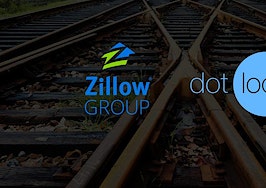Enjoy the Connect experience from your computer, laptop or tablet! Watch Connect now.
Takeaways:
- Zillow beat its own expectations for revenue and EBITDA despite closing the trading day at its lowest stock price in a year.
- The number of agents spending more than $5,000 per month grew 48 percent year over year.
- Zillow reported that Market Leader’s revenues decreased 21 percent to $12.5 million from $16 million in 2Q 2014.
Zillow Group’s integration of former rival Trulia is expected to be complete in the next few weeks, and the company announced in its second-quarter earnings results today that it beat its own expectations for revenue and EBITDA (earnings before interest, taxes, depreciation and amortization) despite closing the trading day at $74.20, its lowest stock price in a year. Its 52-week high was $148.54.
Agent advertising
Zillow Group counted nearly 102,000 agent advertisers during the quarter, and its average monthly revenue per advertiser (ARPA) was $375, up 18 percent from $318 in the same period last year.
According to Zillow Group’s advertiser data, the number of agents spending more than $5,000 per month grew 48 percent year over year; agents spending more than $2,500 per month grew 44 percent year over year; and agents spending more than $1,000 per month grew 34 percent year over year.
“The churn rate among these cohorts is very low, validating our strategy of focusing on high-performing agents,” Rascoff said, but when asked by an analyst to quantify how many agents are in those different spending buckets, Rascoff responded, “Give an inch, and they’ll take a mile.”
“This is more disclosure than you’ve ever gotten about churn by cohort and upsell by cohort,” he said. “Obviously, we have all that data, and we look at it carefully, but no, we’re not going to disclose any more detail for competitive reasons.”
Market Leader
One big question for Zillow remains: What does it intend to do with Market Leader, which Zillow inherited from Trulia? While rumors swirl that Zillow may sell the contact management system, Zillow reported that Market Leader’s revenues decreased 21 percent to $12.5 million from $16 million in second-quarter 2014.
Kathleen Philips, the company’s newly minted chief financial officer, said only that Zillow is conducting “a strategic review” of the Market Leader business.
“We’re continuing to evaluate strategic opportunities, but we’re very mindful of the fact that Market Leader’s clients are very important partners of ours,” she said.
Trends and segments
The trends, though, seem mostly positive, as Zillow reported that its second-quarter revenue increased to $171.3 million from pro forma revenue of $142.8 million in second-quarter 2014, exceeding even the high end of the company’s outlook by $2.3 million. The company’s various segments also fared well:
- Marketplace revenue increased 29 percent to $145.5 million from $112.4 million in 2Q 2014.
- Real estate revenue grew 37 percent to $122.6 million from $89.2 million in 2Q 2014.
- Mortgages revenue grew 44 percent to $10.4 million from $7.2 million in 2Q 2014.
Second-quarter EBITDA was about $21 million, far exceeding Zillow’s outlook of about $4 million. The company attributed this to the shifting of some ad expenses to the third quarter because it achieved audience goals with a lower, more efficient ad spend, as well as the reduction of combined sales team expenses and other synergies.
Across the Zillow portfolio, the company averaged 141 million monthly unique users during the quarter, with its flagship Zillow brand leading the way with a 22 percent growth year over year, according to Google Analytics, and garnering nearly 50 percent of all category visitors, according to comScore.
With comScore also reporting that Zillow brands account for 72 percent of all mobile-only real estate category visitors, this “represents tremendous opportunity for our advertisers, as well as validating our acquisition of Trulia,” said CEO Spencer Rascoff.
“What remains clear to us is that the multibrand portfolio strategy is the right one,” Rascoff said. “Consumers value choices in how and where they can search for their next home and connect with the best local professionals. By operating multiple brands, our audience grows as consumers increasingly engage with Zillow Group brands.”
Dotloop
While the Trulia integration dominated the focus of Zillow’s earnings call, the company had other acquisitions to discuss, including its most recent purchase last month of dotloop, a Cincinnati-based company that claims it can simplify real estate transactions by enabling real estate professionals and their clients to share, edit, sign and store documents digitally. The purchase grew Zillow’s 2,000 employees by about 100.
Financial terms of the dotloop acquisition, which is expected to close in the third quarter, were not disclosed, but Rascoff said, “The consideration for dotloop was substantially in cash. The decision to use cash with retention incentives in stock reflects management and the board’s confidence in the long-term opportunity for Zillow Group, and our overall sensitivity to dilution.”
“There is no question that the real estate transaction is moving online,” Rascoff said. “We have spent the last 10 years innovating the search process. We intend to apply as much innovation to the transaction itself, which is still largely an offline experience. The paperless transaction is here, now. We think we can expand dotloop’s market share by applying Zillow resources to it.”
MLSs and direct listing feeds
The most tangible benefit of what Rascoff referred to as “our massive scale” has been the company’s transition to direct listing feeds in April, he said.
“MLSs, brokerages and agents understood that Zillow Group offered access to the largest consumer home shopping audience, and they signed up at an unprecedented rate,” he said.
“We now receive significantly more high-quality listings directly from MLSs than we did when a third-party vendor provided us with listings, and we now have more than 300 MLSs sending us data directly, having added 81 new MLS partnerships in just the last three months.”
Integration with Trulia
Providing a detailed update on the Zillow-Trulia integration, Rascoff said rentals, mortgages, displays and back-of-the house operations are now fully merged. The integration of the company’s agent advertising business is ahead of schedule and should be complete by the end of the third quarter.
Next up is the incremental rollout of the cross-brand Premier Agent product that combines both mobile and Web presence for agent advertisers, which should be complete in the next few weeks. Account transitions for customers, sales reps and account managers are also mapped out and ready to go.
Once the product is launched, agents will buy advertising from Zillow Group, and their ads will be served across all platforms, including mobile apps, mobile Web and desktop Web, and across the Zillow, Trulia and HotPads brands, as well as the real estate search platforms they power, including Yahoo, MSN, AOL, HGTV and Leju in China.
“We are excited about the significant progress we have made to this point, and are looking forward to gaining further speed as the Trulia integration reaches its final stages,” Rascoff said.
However, overcoming Trulia’s stalled-out topline audience growth is a priority for the company, he noted.
“We are putting significant resources and effort behind it, and we will turn around its traffic trends,” Rascoff said.







